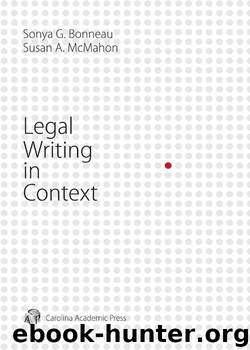Legal Writing in Context by Sonya G. Bonneau & Susan A. McMahon

Author:Sonya G. Bonneau & Susan A. McMahon
Language: eng
Format: mobi
Publisher: Carolina Academic Press
Published: 2017-09-02T00:00:00+00:00
1. Analogies
With analogies, your goal is to show the reader the connection between the precedent case and the current case. Sometimes, these two sets of facts are identical. These are the easy cases that are often resolved before they ever see the inside of a courtroom (or a lawyer's office). The cases that require lawyerly assistance are often far more difficult. In your writing, your goal is to make concrete the sometimes-abstract connections between precedent and current facts. To do so, you must: (1) identify the specific relevant facts, and (2) generalize out from those facts until the tie between the two cases is clear.
The judgment of importance will help with the first task. You decided which facts were relevant when you decided on the similarities that outweighed the differences. An effective analogy focuses the reader's attention on those facts. The tendency for many beginning law students is to include all the facts they know in the analogy. But experienced attorneys know that technique overwhelms the reader and leads to confusion. Irrelevant facts clog up an analogy; a streamlined analogy that focuses attention only on the relevant information is the goal.
Analogies are at their easiest when the two sets of facts closely track one another. When one farmer milks his neighbor's cow without permission, it's easy to draw the connection between that case and the next farmer-milking-cow case that comes along. But those easy cases are usually resolved well before a complaint crosses a court clerk's desk. Often, there is daylight between the precedent case and the new one. A cow becomes an iPad. Neighbors become strangers. A resource taken for convenience becomes one taken in an emergency.
When facts change, when the line from Case A to Case B is no longer straight and direct, then the analogy needs to contain both the specific facts from the precedent and a tie that shows the exact point of overlap between the two cases. To create this tie, a practitioner generalizes out from the specific details of the precedent and the specific details from the current case until the two fact sets overlap. For example, to make an analogy between a cow and an iPad, you could describe both as “things,” but that describes a whole host of objects not relevant to the dispute. You could narrow the generalization by describing them as “possessions” of the farmer. Even more specifically, you could describe these objects as “business possessions” of the farmer, or items that help the farmer in his work. Finding the most specific way to connect the two ideas is key; to be overinclusive is to open your analogy up to devastating hypotheticals from your opponent. One scholar has called this finding the lowest common denominator between the facts of the two cases.11
The below example demonstrates the weakness of analogies without clear ties. This paragraph comes from a memo analyzing a potential false light claim against an artist who had publicly displayed a photo of an unconscious man with a bottle of whiskey at his kitchen table; his wife stares into the camera with a black eye.
Download
This site does not store any files on its server. We only index and link to content provided by other sites. Please contact the content providers to delete copyright contents if any and email us, we'll remove relevant links or contents immediately.
Seven Steps to Confident Writing by Alan Gelb(867)
Point Made - How to Write Like the Nation's Top Advocates by Ross Guberman(577)
Point Made by Guberman Ross(575)
Point Taken - How to Write Like the World's Best Judges by Ross Guberman(549)
A Primer on Legal Reasoning by Michael Evan Gold(513)
Legal Writing Exercises: A Practical Guide to Clear and Persuasive Writing for Lawyers by E. Scott Fruehwald(509)
Beyond the First Draft: Editing Strategies for Powerful Legal Writing by Megan McAlpin(492)
Plain English for Lawyers, Sixth Edition by Richard C. Wydick & Amy E. Sloan(460)
Thinking Like a Writer: A Lawyer's Guide to Effective Writing & Editing by Stephen V. Armstrong & Timothy P. Terrell(448)
The Complete Legal Writer by Alexa Z. Chew & Katie Rose Guest Pryal(441)
Writing for the Legal Audience, Second Edition by Wayne Schiess(417)
Legal Analysis: 100 Exercises for Mastery, Practice for Every Law Student (2012) by Hill Cassandra L. & Vukadin Katherine T(416)
Legal Writing in Context by Sonya G. Bonneau & Susan A. McMahon(378)
